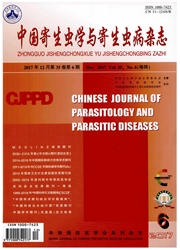

 中文摘要:
中文摘要:
目的 评估云南省边境地区疟疾传播风险,为边境地区调整疟疾防控措施和消除疟疾行动策略提供依据。 方法 根据已经建立的疟疾传播风险评估指标体系框架,收集云南省2012-2014年边境地区20个县197个乡(镇)的疟疾疫情、传疟媒介分布和机构工作能力等数据资料。经专家会商确定评价指标赋值标准,并对197个乡(镇)的各评价指标按照赋值标准进行评分,计算疟疾传播潜能指数(TPI)、消除疟疾防控能力指数(ICI)和疟疾传播风险指数(MRI),用离差法对各指数进行等级划分,以地理信息系统软件绘制乡(镇)的疟疾传播风险等级分类地图。 结果 按TPI划分等级,197个乡(镇)中,Ⅰ级(高传播潜能)乡(镇)共2个,分别是盈江县的那邦镇和沧源县的班老乡;Ⅱ级(中传播潜能)乡(镇)共11个,Ⅲ级(低传播潜能)乡(镇)共184个,在各县均有分布。按ICI划分等级,197个乡(镇)中,Ⅲ级(疟防能力弱)乡(镇)共4个,分别是西盟县的中课乡、腾冲市的中和镇和滇滩镇、景洪县的勐罕镇;Ⅱ级(疟防能力中等)乡(镇)共20个;Ⅰ级(疟防能力强)乡(镇)共173个,在各县均有分布。根据MRI分级, 197个乡(镇)划分为3个风险等级,Ⅰ类(高传播风险)乡(镇)共2个,分别为盈江县的那邦镇和沧源县的班老乡;Ⅱ类(中等传播风险)乡(镇)共12个;Ⅲ类(低传播风险)乡(镇)共183个,分布于20个边境县。 结论 云南省边境地区20个县197个乡(镇)中,疟疾传播风险中等以上的Ⅰ、Ⅱ类乡(镇)所占比例小于5%,大部分乡(镇)的疟疾传播风险相对较低。
 英文摘要:
英文摘要:
Objective To assess the malaria transmission risk in the border area of Yunnan Province and provide evidence for adjustment of malaria intervention and elimination strategies. Method Data concerning malaria prevalence, vector distribution, and institutional intervention capacity were collected in 197 towns of 20 counties in the border area of Yunnan Province during 2012-2014. The malaria transmission potential index (TPI), intervention capacity index(ICI) and malaria risk index(MRI) were calculated for each town, based on the criteria formulated by a professional committee. The towns were categorized according to the indices aforementioned. The risk map was created with GIS software. Results Based on the TPI, the 197 towns comprised of 2 grade-I towns(including Nabang in Yingjiang and Banlao in Cangyuan) with high transmission potential, 11 grade-II towns with moderate transmission potential and 184 grade-III towns with low transmission potential. Based on the ICI, the 197 towns comprised of 4 grade-III towns(including Zhongke in Ximen, Zhonghe and Diantan in Tengchong, and Menghan in Jinghong) with a weak control capacity, 20 grade-II towns with a moderate control capacity and 173 grade-I towns with a strong control capacity. Based on the MRI, the 197 towns comprised of 2 grade-I towns(including Nabang in Yingjiang, and Banlao in Cangyuan) with a high transmission risk level, 12 grade-II towns with a moderate level and 183 grade-III towns with a low level distributed in 20 counties. Conclusion The grade I or II towns with moderate and high transmission risk constitute 〈5% of the 197 towns in the border area, suggesting a relatively low level of malaria transmission risk in most counties.
 同期刊论文项目
同期刊论文项目
 同项目期刊论文
同项目期刊论文
 期刊信息
期刊信息
